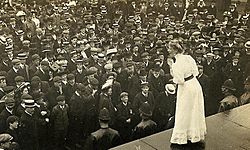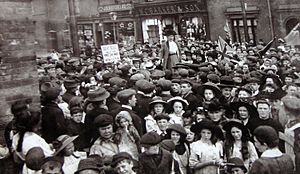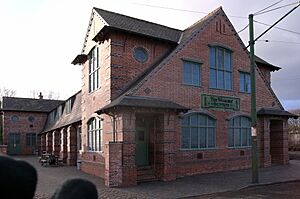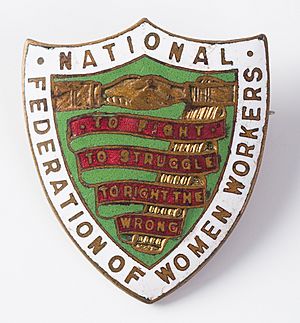National Federation of Women Workers facts for kids

Mary Macarthur addresses a mass meeting in London during the 1908 Corruganza strike
|
|
| Merged into | NUGW |
|---|---|
| Founded | 1906 |
| Dissolved | 1921 |
| Location | |
|
Members
|
40,000 (1914) |
|
Key people
|
Mary Macarthur, General Secretary (1911–1921) Gertrude Tuckwell, President (1911–18) |
The National Federation of Women Workers (NFWW) was an important organization in the United Kingdom of Great Britain and Ireland. It helped women workers get fair treatment in the early 1900s. The NFWW was key in winning women the right to a minimum wage for the first time. It also helped more women join trade unions in general.
Unlike many smaller unions that only allowed certain skilled workers, the NFWW started in 1906. It was a general union open to all women. This included women in many different jobs where wages were low. Before the NFWW, it was hard for women in these jobs to join unions.
A Scottish woman named Mary Macarthur was very important to the NFWW. She led campaigns against "sweated industries." These were places where people worked very long hours for very little pay. Mary Macarthur also helped striking workers and pushed for new laws. She worked with other groups to improve workers' rights.
In 1921, the NFWW joined with the National Union of General Workers. It became the women's section of that larger union.
Contents
Why Was the NFWW Formed?
The NFWW was created because other trade unions often did not allow women to join. When the NFWW first started, many male-dominated unions did not like the idea of "organized women." They thought women joining unions would hurt the status of the movement. This was partly because women could not vote at the time.
Before the NFWW, there was a group called the Women's Trade Union League (WTUL). The WTUL encouraged women to join unions. However, the WTUL was not a union itself. It was more like a support group for women who were already in other unions.
A failed strike in 1906 showed the need for a strong union for women. Women working in the Dundee Jute industry went on strike. But the WTUL could not raise enough money to help them. This showed that a dedicated union for women was needed.
The NFWW believed that existing unions should open their doors to women. However, the Trades Union Congress (TUC) did not allow unions with both men and women to join them. So, an all-female union was necessary. The NFWW played a big part in convincing the Liberal Party to create the Trade Boards Act 1909. This law set minimum wages for jobs where many women worked.
How Did the NFWW Grow and Succeed?
By the end of 1906, the NFWW had 17 local groups and 2,000 members. By 1914, its membership grew to about 40,000 women.
The union's first big success happened in 1908. They supported women workers on strike at the Corruganza box factory in Summerstown, London. The workers were striking because their wages had been cut. Sophy Sanger, an NFWW organizer, helped the workers. She negotiated a deal that brought wages back to their original levels for most jobs.
In 1910, the NFWW helped about 800 women who made chains in Cradley Heath. These women were denied the new minimum wage of 11 shillings (55p) per week. This minimum wage was set by the Trade Boards Act 1909. For six months, bosses could make workers agree to lower pay. This worried the NFWW. They feared employers would stock up on cheap chains and then fire workers once the minimum wage was set.
Mary Macarthur was also worried that the new minimum wage might seem to cause job losses. The NFWW worked with fair employers who paid the minimum wage. They promised these employers that unfair competitors would not have an advantage. To do this, workers at companies refusing to pay the minimum wage went on strike in August 1910.
A special fund raised about £4,000 (around £450,000 today) to support the striking workers. The NFWW and Mary Macarthur got a lot of support from newspapers. Money was collected in towns across the United Kingdom and Ireland. Collections happened outside churches, at football games, and at Labour Party meetings. A Pathé news film about the strike was shown in cinemas. This helped the union get public attention.
Within a month, 60% of the employers agreed to pay the minimum wage. After 10 weeks, the last employer agreed on October 22, 1910. The strike successfully raised wages. The money left over from the strike fund was used to build the Cradley Heath Workers' Institute.
In 1913, the NFWW also helped with a long strike in Kilbirnie, Ayrshire. This strike involved women who made fishing nets. It lasted from April to September 1913. It was the longest strike by women workers recorded at that time. NFWW activist Kate McLean led the strike. The community strongly supported it. For example, 10,000 supporters attended a meeting in Kilbirnie in May 1913. The net workers' dispute ended on September 2, 1913. It resulted in better wages and working conditions, thanks to the NFWW.
How Did World War 1 Affect Women Workers?
During the First World War, many women took jobs that men had left to join the army. Between 1914 and 1918, about one million more women started working. However, many found bad working conditions, low pay, and long hours. This led to many strikes and disagreements with employers. Trade unions, including the NFWW, supported these actions. During the war, women's union membership grew by 160%. The NFWW's actions were successful during the war. This was because employers and the government needed workers and wanted to avoid problems.
The NFWW's first important action during the war was at Ainsworth Mill in Cleator Moor in 1915. This mill made khaki thread for soldiers' uniforms. Workers were paid very low wages, only seven to nine shillings for a 60-hour work week. William Anderson, a local Labour Party MP and husband of NFWW leader Mary Macarthur, asked for an investigation into the low pay.
A strike of 250 women and 20 boys followed. After six weeks, the workers received a 10% "War bonus" pay increase. The NFWW also gained official recognition from the company. In the same year, the NFWW group at the Hayes munitions factories had many members. Over half the women working there joined the union in 1915. A union group demanded equal pay for women. Men were paid seven pence an hour, while women only got three and a half pence.
Following these successes, the NFWW helped workers in 1916. They staged a sit-in protest at a munitions factory in Newcastle. The company had not paid a wage increase that a tribunal had ordered. During the sit-in, the workers knitted socks for soldiers. They refused to operate the factory machines. Winston Churchill, who was the Minister for Munitions, called Mary Macarthur. He was angry and demanded to know why the workers had stopped. Macarthur told Churchill the women would not go back until they received their missing wages. After 24 hours, the company gave in and paid the back wages.
Later in 1916, over 2,500 young women went on strike in April at Greenwood and Batley's factory in Leeds. The NFWW supported them. Their dispute was about the huge pay differences between the highest and lowest paid staff. The company called the action "unorganized and irresponsible."
Strikes became more common in the UK as the war continued. Wages did not keep up with rising prices. Also, workers were expected to work longer hours to help the war effort. In 1917, the NFWW helped with a dispute at Thomas Summerson and Sons. This company made railway points in Darlington. Twenty-one female workers were fired after two of them attended a meeting about wages. The NFWW argued that the company was punishing the workers. The union demanded that all 21 workers be hired back.
The NFWW's actions during the First World War showed its strength as a union. This also happened at a time when there were bigger talks about women's rights, including the right to vote.
What Happened to the NFWW Later?
The NFWW was involved in the 1918 tram and bus strikes in West London. By the end of the war, the London General Omnibus Company employed 3,500 women. Many other companies also had a lot of female workers. They demanded "equal pay for equal labour" for women workers.
The NFWW took part in the 1919 International Congress of Working Women. Mary Macarthur was one of two representatives from the United Kingdom. The other was Margaret Bondfield from the Trades Union Congress.
In 1920, the NFWW joined with the National Union of General Workers (NUGW). At first, it was a special section within the NUGW for women workers. People thought that being part of a larger union would be helpful. They also hoped that women would keep their own identity within the NUGW. This "district" status meant women had direct representation. However, by 1930, this special status was lost. This meant women no longer had direct representation in the NUGW's leadership or at the Trades Union Congress.
The Woman Worker Newspaper
The NFWW was well-known partly because of its newspaper, The Woman Worker. This paper shared stories, funny tales, and ads related to NFWW members. It started as a monthly paper. But it became so popular that it was published weekly. It sold about 20,000 copies.
In the first issue, Mary Macarthur wrote about the paper's goal. She said it aimed "To teach the need for unity, to help improve working conditions, to present a monthly picture of the many activities of women Trade Unionists, to discuss all questions affecting the interests and welfare of women."
While much of the paper focused on unionism and women's rights, it also had lighter content. For example, it included features like 'The Art of Beauty' and 'Home Hints'.





